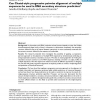40 search results - page 4 / 8 » High quality protein sequence alignment by combining structu... |
BMCBI
2005
13 years 10 months ago
2005
Background: The sequencing of the human genome has enabled us to access a comprehensive list of genes (both experimental and predicted) for further analysis. While a majority of t...
HPDC
2010
IEEE
13 years 11 months ago
2010
IEEE
A common task in biological research is to predict function for proteins by comparing sequences between proteins of known and unknown function. This is often done using pair-wise ...
RECOMB
2003
Springer
14 years 10 months ago
2003
Springer
Protein sequence alignments are more reliable the shorter the evolutionary distance. Here, we align distantly related proteins using many closely spaced intermediate sequences as ...
ICASSP
2007
IEEE
14 years 4 months ago
2007
IEEE
Protein structure prediction aims to determine the three-dimensional structure of proteins form their amino acid sequences. When a protein does not have similarity (homology) to a...
BMCBI
2007
13 years 10 months ago
2007
Background: In ribonucleic acid (RNA) molecules whose function depends on their final, folded three-dimensional shape (such as those in ribosomes or spliceosome complexes), the se...

